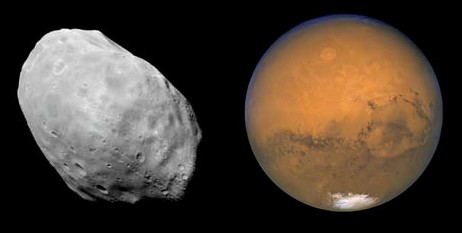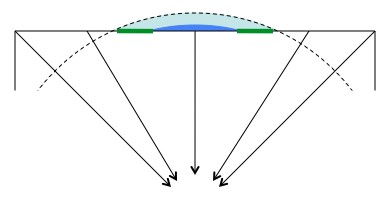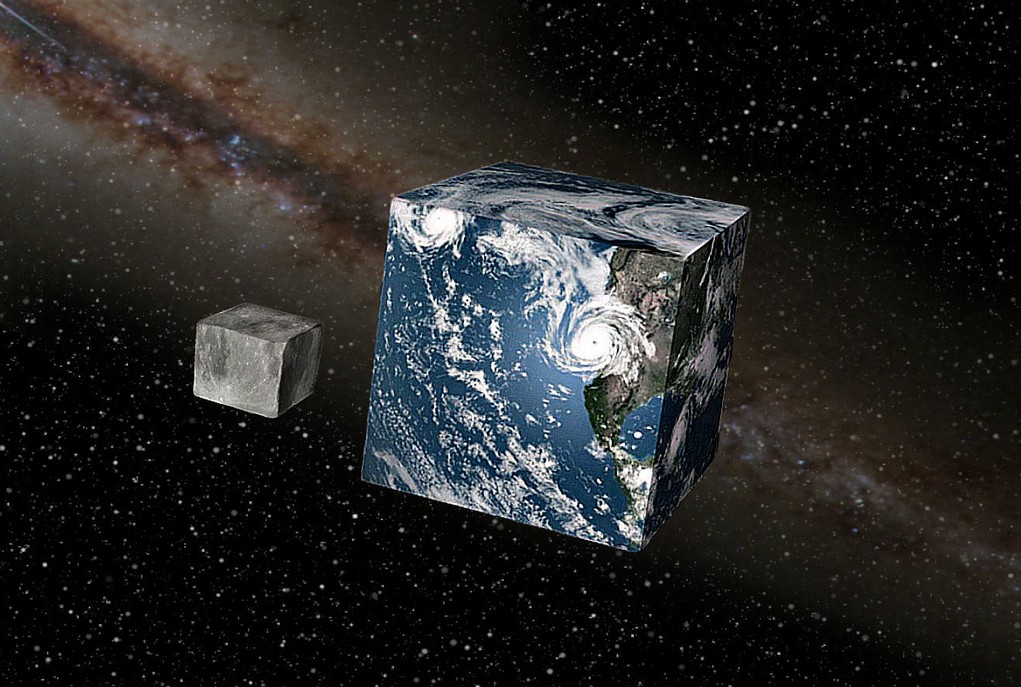Physicist: The Earth is really round. It’s not the roundest damn thing ever, but it’s up there. If the Earth were the size of a basketball our mountains and valleys would be substantially smaller than the bumps on the surface of that basketball. And there’s a good reason for that.
Rocks may seem solid, but on a planetary scale they’re squishier than soup. A hundred mile column of stone is freaking heavy, and the unfortunate rocks at the bottom are going to break in a hurry. Part of what keeps mountains short is erosion, but a bigger component is that the taller a mountain is the more it tends to sink under its own weight. So as a planet gets bigger, and gets more gravity, the weight of the material begins to overwhelm the strength of that material, and the planet is pulled into a sphere.

Phobos (left), a very small moon, isn't big enough to generate the gravity necessary to crush itself into a sphere. Unlike its host planet Mars (right).
So a tiny planet could be cube shaped (it’s not likely to form that way, but whatev’s). Something the size of the Earth, however, is doomed to be hella round.
Life on a cubic Earth would be pretty different. Although gravity on the surface wouldn’t generally point toward the exact center of the Earth anymore (that’ a symptom of being a sphere), it will still point roughly in toward the center. So, the closer you are to an edge, the more gravity will make it feel as though you’re on a slope. So, although it won’t look like it, it will feel like each of the six sides forms a bowl. This has some very profound effects.

If you walk around the Earth's equator (left) your altitude says almost perfectly even. If you walk around the cube-Earth's equator, cutting four of the faces in half, you'd experience "altitudes" as high as 2,600km (Everest is 8.8km). The 8 corners of the cube would be 4,700km higher than the centers of each face.
The seas and atmosphere would flow to the lowest point they can find and as such would puddle in a small region in the center of each face, no more than a thousand miles or so across. However, both the seas and atmosphere would be several times deeper. Which doesn’t count for as much as you might think. Here on Earth (sphere-Earth), if you’re around 5km above sea level most of the air is below you.
The vast majority of the Earth would take the form of vast, barren expanses of rock, directly exposed to space. If you were standing on the edge of a face, and looked back toward the center, you’d be able to clearly see the round bubble of air and water extending above the flat surface. I strongly suspect that it would be pretty.
All life (land based life anyway) would be relegated to a thin ring around the shore of those bubble seas a couple dozen miles across.

Cross-section of a face: Gravity still points roughly toward the center of the cube-Earth. As a result the water (blue) and air (light blue) flows "downhill" and accumulates at the center of each face. The only land that could be inhabited is the land surounding the sea, where the air meets the ground (green lines). This picture is way out of scale. There is no where near this much air and water on our Earth.
Assuming that the cube was oriented in the way most people are probably imagining it right now, with the poles in the center of two of the faces, then two of those bubble seas would take the form of solid ice cap blocks.
What’s really cool is that the cube-Earth would have 6 completely isolated regions. There’s no good reason, beyond some kind of “local panspermia“, for the life on each face to be related to the life on each of the other faces. If the biospheres took different routes you could even have a nitrogen/oxygen atmosphere on some faces (like we have) and a hydrogen/nitrogen/carbon-dioxide atmosphere on others (like our old atmosphere 3 billion years ago).
The small area would also affect (end) large-scale air and water movement. You wouldn’t have to worry about hurricanes, but the cube-Earth would also have a really hard time equalizing temperature. If you’ve jumped into the Pacific Ocean on the west coast (of the United States) you’re familiar with the teeth-chattering horror of the Arctic currents, and if you’ve been in the Atlantic Ocean on the east coast (USA again) you’re no doubt familiar with the surprisingly pleasant equatorial currents. Point is: there’s a lot of thermal energy being carried around by the air and water. On cube-Earth you’d have to deal with huge seasonal temperature fluctuations.
If I had to guess; it’s unlikely that complex life would evolve on a cube Earth. However! If it did, then their space program would be as easy as a long walk, and their handsomest physicists would spend their time pondering what a round Earth would be like.
By the by, the cube earth photo is by “Altered Realities“.
Update: The dude over at Possibly Wrong went through a bunch of the math behind the gravity of cube earths, and filled in a lot of the details that this post left out. It’s clearly presented, and well worth a look: Possibly Wrong: If the Earth Were a Cube.








The mid night sun effect would be massive.
Just a small tilt would cause it t0 happen to a whole face for 6 months.
Pingback: Anonymous
Pingback: TWSB: Well, it certainly would make the cartographer’s job easier… « Eigenblogger
It would be funny though cuz if we looked square ourselfs we would look like someone in MineCraft. XD
What’s about Earth rotation and Earth axis orientation?
Does this effect have considerable contribution to water arrangement?
Probably there are two ultimate systems with axis oriented
1. through opposite cube faces
2. through opposite cube corners.
The only real difference the rotation axis has is on the centrifugal forces, which are tiny compared to the gravitational force. So the water distribution should be fairly independent of axis.
That doesn’t explain much but thanks!
Pingback: Если бы Земля была не шаром, а кубом? | Всё самое интересное в интернете! Креативная реклама
looks like minecraft!
if I am right earth quake history says that millions of years ago earth quakes was seldom. like not to often. but now they are every day by the rate of dozzonds a day.
the center of the milkey way galaxy is a massive black hole. that’s what makes galixys in the first place. and we are being pulld into it. however long. I think in 1000 more years earth will start to fall apart a little at a time. islands sinking. more powerfull quakes. as a mater of fact the andies mountains are growing by a foot a year. better start looking for a new planet.
Pingback: The Science Of Imagine Nations: Planets
The earth is a circle not a cube lol
Pingback: Conspiracy Theories Directory The Earth is flat | Conspiracy Theories Directory
Pingback: TWSB: Well, it certainly would make the cartographer’s job easier… | Eigenblogger
Pingback: Is Earth Actually Flat? | User Generated TV
So on this cubed planet, would there still be northern and southern hemispheres? If so, will they be on EACH face of the cube, so that there will be a total of 12 hemispheres (6 faces x 2 hemispheres, north & south)? How will the weather and temperatures differ on each face/hemisphere? And when the cube orbits, will it still have the 23.5 degree tilt as our spherical Earth has currently? On which part will the axis go through, the top and bottom faces or the diagonal opposite corners? I’m sorry for my myriad of questions!!
Pingback: ¿Cómo sería la Tierra para nosotros si fuera cúbica? ¿Es eso posible? | Ojos compuestos
what is formulation to transformation a cube into a spherical
Pingback: Is Earth Actually Flat? | Woowix
If the Earth were not round, how would that affect the Earth’s position in space and time, It’s position in the fabric of space? Per Albert Einstein’s theory! Gravity?Electro magnetics? Molecular level? Also the flow of the core? ect…
Thank you for this bit of knowledge, but if we did in fact live on a cubed earth and our world was based as you say, how would that effect the way that the millions of generations of animal and plant species has grown? not to mention humans? Would plants be mangled and dark things or would they be massive and towering beacons of life, because of the high concentration in water and c02 and oxygen? And wouldn’t daylight last for months, and darkness the same? Would most life be water based because so much of the world water would be in one place? would the rest of the world seem to be bottomless pits because of the absence of water, as it does run pretty deep? Or would the makeup of our world be completely different, with nothing the same?
I’m 13, I’m sorry if these answers are obvious?
Never be sorry for asking questions ….the mind is a beautiful thing…if we did not question or ask the world as we know it would not be. If you can imagine it, it can happen. Look at the universe. We were the center for a long time…hmm. and you have great questions!
Pingback: Is Earth Actually Flat? | www.vcliper.com
Pingback: If the Earth Were a Cube | zeitgeist777
Pingback: Ask a Mathematician / Ask a Physicist | zeitgeist777
Pingback: Is Earth Truly Flat? — Follow, Index, Nofollow & Noindex
It did give me information but would all living things still exist?
how would a rainbow look like from the surface of a cube shaped earth?
Pingback: Could Planet Minecraft Actually Exist? | Our Ladies and Gentlemen
Pingback: Could Planet Minecraft Actually Exist?
Pingback: Why Is Our Earth A Ball Instead Of A Cube? The Science Guy Finally Answers -E
The water (and the atmosphere) does “bulge” around the equator. The earth itself bulges around the equator. The average diameter of the earth at the equator is about 29 miles greater than the polar diameter.
If the earth were cube how would the elevations of the north star change assuming it were far away?
@cam
If you play Minecraft, you would notice that it’s worlds are infinite, therefore it wouldn’t loop back around like that.
this is really cool! could you do one about an egg shaped earth?